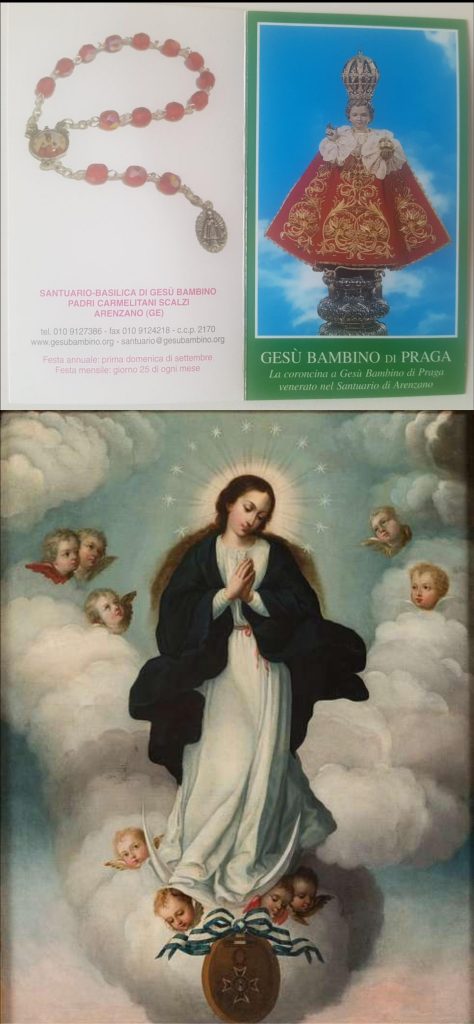First, a safety reminder to protect your eyes: On your computer, turn the screen light as low as possible without it straining your eyes. Also, use dark mode if you feel that that is better for your eyes. Moreover, try a screen projector for your computer: Via projecting the computer screen onto a wall, the computer user does not have to stare directly at a screen. The author has composed this article both with the use of a projector and with the computer in dark mode. For him, that set up is much, much easier on his eyes: The projector alone is much easier. The projector in dark mode is much, much easier. (However, such a set up requires a light-colored wall or other suitable area on which to project, adequate distance to project the screen, and a room that is dark enough. Lastly, even if you do not have eye trouble now due to computer and mobile device use, that eye trouble could start in the future. Therefore, using a computer projector might be the way to prevent eye trouble before it happens.)
Infant of Prague fertility aid and Mary on the Moon and Mary Is the Moon
Illuminating, heavenly message from soul of Saint Teresa of Jesus reveals a hidden use for the Infant of Prague Chaplet: Very surprisingly, the Chaplet is also a fertility device to help conceive a boy! . . . Amazingly, that otherworldly message from Santa Teresa ultimately revealed what must be the prime, original, fertility-related meaning of one ancient icon of Mary: her stepping on the crescent moon! Wow!
Visionary and author: Mark (Max) Gruber
Originally published: Later Winter 24/25
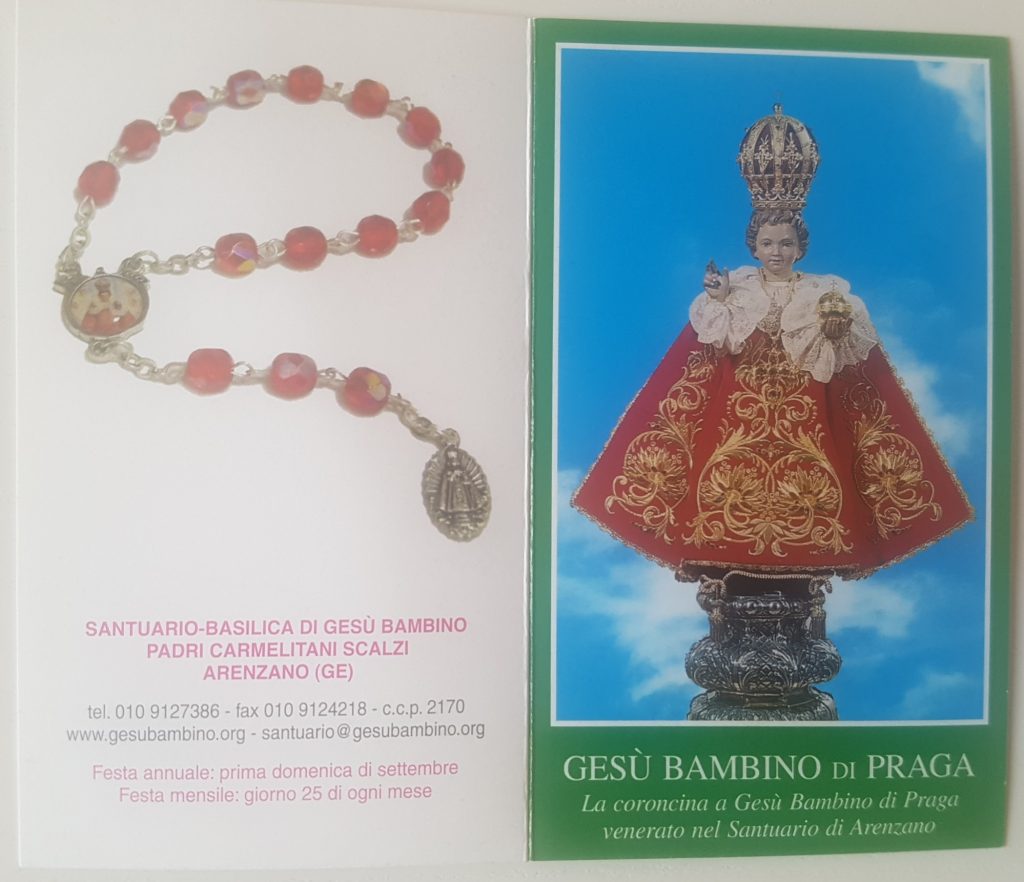
Above: Front and back of the opened prayer card at which I was staring when Saint Teresa spoke to me.
PART I: MESSAGE FROM SOUL OF SAINT TERESA ABOUT THE INFANT OF PRAGUE CHAPLET–IT’S A FERTILITY DEVICE!
Message from Saint Teresa
15 October 2024 was the Feast Day of Saint Teresa of Jesus, who is also known as Saint Teresa of Avila. (To this great saint, first female doctor of the Church, I am exceedingly close. In fact, about 3.5 years before this time of writing, I was, via Saint Teresa, brought to a much higher level of faith that has, over these past years, proven to be a correct comprehension of God.) On that mid-October day, in the sacristy of my local church of Saint Teresa of Jesus, I received a personal, individual blessing from my local bishop (His Excellency, Bishop Gianmarco Busca, President of Liturgy of the Italian Bishops’ Conference). Then, at home, five-days later, on Sunday, 20 October, I perceived a heavenly message from the soul of Saint Teresa of Jesus. I was graced with the divine communication while I stared at a pictured Infant Jesus of Prague icon alongside a photo of an Infant Jesus of Prague Chaplet (which has 12 beads in a circle, followed by 3 beads in a line). At that wondrous moment, Saint Teresa explained to me a hidden usage of the Infant of Prague Chaplet (which was graced to us through the Venerable Sister Margaret of the Blessed Sacrament): The chaplet’s beads are to be used by women who want to conceive a baby boy!
Saint Teresa said that the first bead, of the circle, is counted on the first day of a woman’s monthly cycle (on average, 28 days). Then, for 12 days including that first, that woman is not to have intercourse with her husband. Those 12 days are represented by such a woman counting all of the circle’s 12 beads. After that, the woman can start to have intercourse on the 13th day, which is signified by the 13th bead (the first bead in the row of three beads outside the circle).
The above was what Santa Teresa relayed to me.
At the time, I was certain that the heavenly message was genuine. I was so certain that, in November of 2024, when I next saw and spoke to Bishop Busca, I told him that I had received an otherworldly message from Saint Teresa of Jesus. Specifically, I said that she informed me that the Infant of Prague Chaplet can be used as a fertility device to promote the birth of boys.
Shettles method
At the time of Santa Teresa’s message, I had been aware of what was called the Shettles method of selecting a baby’s sex: having intercourse near and at the time of ovulation to increase the likelihood of having a male baby. Therefore, and in the way that God speaks to someone at a level that that someone could understand, Santa Teresa’s message to me made sense right away: I knew that the average female should ovulate on day 14; and, I also thought, since the length of female cycles are not exact, if 14 is the most-usual day of ovulation, 15 must be the next-most-usual day: for those women with a slightly longer cycle (or, 13 must be the next-most-usual day for ovulation for those women who have slightly shorter cycles).
I also knew that, besides having intercourse at ovulation, the Shettles method advises intercourse just before ovulation. Therefore, on the 13th day of a regular, 28-day, female cycle, intercourse on the 13th day should, per the Shettles method, also more likely lead to a boy.
Bishop Busca, when I told him the eye-opening news, also knew of the Shettles method (which, of course, as there is nothing new under the sun, must have been recognized in ancient days—although it was, of course, not then called the Shettles method, as Shettles is a scientist from the 20th Century).
My investigations
An authentic heavenly message must be true. Therefore, because, via speaking to the Bishop and not, rather, keeping the otherworldly communication private, I had mushroomed this supernatural matter into something serious, I decided to investigate scientific findings about the Shettles method. What I discovered is that there exists much contradictory, scientific evidence about whether a woman is more likely to have a boy or a girl when she has intercourse just before or during ovulation: The following A, B, and C points of information are what I discovered (some of which, such as what was earlier detailed, I already knew):
(A) Some say that to achieve the conception of a male via a timing method, both there should not be intercourse until day 13 of the female’s cycle and sex should take place on both that day and day 14, which is the day of ovulation (speaking of a 28-day cycle). Again, in modern times, such a method is called the Shettles method; and, the scientific evidence from Shettles himself claims an approximate 75-80% success rate in choosing boys or girls (see this link, which speaks of a variety of confirming and opposing findings).
Regarding the Shettles method (by another name) also being ancient: Physiologically, human males are faster than females. So, it is certain that enough of the ancients considered the idea that male-bearing sperm were faster than female-bearing sperm. Meaning, the ancients could have easily speculated that intercourse closer to ovulation should be more likely to bear more boys. Then, they could have tested their hypothesis.
The Shettles method also says that sex prior to day 13 (in the fertile period of a woman’s cycle, which could start, say, on day 10) is more likely to produce a girl. In fact, the Shettles method states that, for a girl, intercourse should be on day 11 and 12 of the cycle (assuming ovulation is day 14).
(B) In contrast to the findings of Shettles and certain other researchers, many other scientists state that there exists no real evidence that Shettles’ timing method of sex selection produces real results (link).
(C) There do exist some studies to show that when intercourse occurs up until three days after ovulation there is more likelihood of having a boy (link and link).
Regarding the contradiction between points A and B, it is known that y-chromosome sperm are slightly lighter than x-: X-chromosome sperm have more DNA and are larger. It is those differences that allow centrifuges to separate y-chromosome sperm from x-, with a reasonably high success rate. Therefore, assuming all else in the two different sperm are the same, how could it be that the y-sperm are not faster? Logically, it seems that the y-bearing sperm must be quicker.
I have seen findings that claim that there is no difference between y- and x-bearing sperm. However, and unless I missed something, I have not found that any of such findings have explained how there logically can be no difference when y-sperm are lighter. For y-sperm and x-sperm to be the same speed while y-sperm are lighter, the x-sperm must have more power to compensate for the extra weight. But, such findings, that have found no differences between the two sperms, do not claim that x-sperm are more powerful. Therefore, it seems to me that something is missing from these findings that claim that the sperm are the same. Can I be mistaken (barring the following proviso)?
Shettles also claimed that the acidity or alkalinity of vaginal mucus has an affect on sperm. With that in mind, I can fathom that the consistency of vaginal mucus might favor one type of sperm more than the other; and, such favoritism could add or detract from speed differences. Meaning, if y-sperm are faster and the vaginal mucus just before and at ovulation favors y-sperm, it must surely be that sex at that time is more likely to produce a boy (since the y-sperm both are lighter and more environmentally favored). However, if y-sperm are faster and the vaginal mucus at the time of ovulation favors girls, then that favoritism could cancel out the advantage of the y-sperm’s faster speed to the degree of even favoring the birth of girls. The previous is the proviso which might be the equalizer.
The help of AI
Now, to return to Santa Teresa’s message, because points A and B are contradictory, Santa Teresa must more value point A over B. With that in mind, I, with the following question, went to ChatGPT (which seems to me to be the best Artificial Intelligence program in current, general use): “I am only interested in online reports from users of the Shettles method of baby sex selection. What is the percentage success rate from a compilation of online users, if available?”
This came from the AI reply (below is identical):
“Success Rate for Gender Selection (Male): Many users claim success when trying for a boy with the Shettles method, particularly when they follow the advice of timing intercourse closer to ovulation and ensuring deeper penetration. The success rate among online users often ranges from 60% to 75% for conceiving a boy, with the idea being that Y-chromosome (male) sperm swim faster but are less resilient, so timing is crucial.”
Then I asked: “Is there any link to any compilation of online users who have made report of their own experience?”
The AI response: “While I cannot directly link to specific online forums or databases, there are several places where people share their experiences with the Shettles Method of gender selection. Many of these discussions can be found on forums, blogs, and social media platforms. If you’re looking for compilations of user-reported success rates or personal experiences, here are some popular platforms and sources where you can find such data . . .”
I wanted to know about user experiences because scientific findings have been mixed. Also, I am aware of both problems with AI and the degree that such self reports can be unreliable. Nonetheless, since the scientific findings were contradictory, it seemed to me to be reasonable to determine the views of online users of the Shettles method.
What Santa Teresa’s message must really mean
Now, and also considering the earlier-mentioned point C (“. . . when intercourse occurs up until three days after ovulation there is more likelihood of having a boy), the following is what I more image to be what Santa Teresa meant with her brief message about the Chaplet being used as a fertility aid to produce male babies:
At the start of a woman’s cycle, she counts one bead a day for 12 days. During that time, she refrains from intercourse. Then, from the next day—which is the 13th day and the 13th bead counted—she can start to have intercourse. Sexual intimacy continues for the 14th and 15th days, which equate to the 14th and 15th beads of the Chaplet. Then, on the 16th day, she starts to count beads backwards. That is, she counts what was the 14th bead as the 16th. Because that bead is in the line of three beads, she can have intercourse on that day. The day after, she can continue to have sexual relations with her husband; and, she counts what was the 13th bead as the 17th bead. Then, with no more beads in the central line (there are three, which are counted as five days), she stops having sex on day 18. Day 18 is counted as the bead that once was the 12th bead, which is inside the Chaplet’s circle.
In such a way, that woman will be having intercourse on two of her most fertile days (13th and 14th), which are days which should produce more boys per the Shettles method (actually, some have found that the 13th day of a 28-day cycle is the most fertile of all days). Moreover, if the conception occurs on one of the few days after ovulation, that is, from the 15th until the 17th, she is more likely to have a boy: per the findings from the studies linked at the above point C. (However, such evidence more regards days 16 and 17, that is, 2-3 days after ovulation. Also, at that second of the two point-C links, it also states that its study found that slightly more girls were born when conception happened at ovulation. Meaning, some of point C partly contradicts the Shettles method.)
Did not know before
Amazingly, it was only on 29 November 2024 when I first learned of those point-C findings about the greater likelihood of conceiving a boy when intercourse occurs after ovulation. I had not known those details at the time that I had received the heavenly message from Saint Teresa. I only learned of it on 29 November because, on that date, I searched and searched the Internet to figure out how Saint Teresa’s message was true.
I searched because, due to all the contradictory findings against the Shettles method, I needed to better comprehend how the message was true. However, I knew that the message had to be true. I knew because, some days before, when I again saw Bishop Busca (to tell him what Saint Teresa had said), God, Who cannot be fooled, provided me with a supernatural grace with which I would not have been provided had I been lying to myself about having heard from Saint Teresa.
Bishop’s remark
When I spoke to the Bishop, whom I had not seen since the Feast of Saint Teresa, I mentioned these two, following matters to him: First, I told His Excellency of Saint Teresa’s supernatural message about the Chaplet’s use as a fertility aid. Second, I revealed to him a related understanding that I had (just then, in the sacristy) suddenly come to recognize about a particular, Biblical icon of Mary (more details eventually follow about that icon: of Mary stepping on a crescent moon and surrounded by twelve stars).
Then, to what I had said to him, and particularly about the icon of Mary, the Bishop, with eyes that spontaneously grew wide, exclaimed, “THIS IS THE MESSAGE!” It was during that meeting with the bishop that God provided me with that supernatural grace (discussed with the Bishop, although unstated in this article other than to mention that such a grace occurred in front of the cathedral’s highly venerated icon of the Queen of Mantua).
Coming back to the Chaplet
To return to the Infant of Prague Chaplet: Imagine that a woman, who is using the Chaplet as a device to aid fertility and more likely ensure the birth of a boy, did not get pregnant—even though she had intercourse on those five days symbolized by the three beads in the line. When such a woman, on a 28-day cycle, continues to count the beads, she should reach the last one, the 29th, at the exact time of her next menses so that she then starts the count again. That is, the 29th bead is the same as the very 1st bead: On which day, if she is in a predictable, 28-day cycle, she should have her period! So, on the next day, she moves to bead 2 and then continues what she did last month. Meaning, she does not really count to 29, but goes back to 1 after 28, since the last bead is also the first (“I am the alpha and the omega”).
Wonderfully, if she has no period when returning to that 1st bead, there exists, from that day, the likelihood that she is pregnant! Then, she counts another bead everyday. The more beads that she counts with no menstruation, the more and more likely it becomes that she is pregnant. Moreover, even if she is pregnant,she still continues to count. She still counts because all that she should need to do is count a decade in total number of whole repetitions on the Chaplet and she gives birth: which usually occurs 280 days after the last period before she conceived!
Every cycle on the Infant of Jesus Chaplet is 28 days because the 29th bead is also the first bead and it is counted not as 29, but, rather, as the first bead of the next cycle. Therefore, to reiterate, if there is no period after the first count and she is pregnant, she continues to count nine more cycles to make a total of a decade and she should give birth. Of course, these ten cycles can be counted using only the two hands’ fingers.
Promise to Fr. Cyril
Nearly four-centuries ago and only years before the Venerable Margaret was graced with the Chaplet, the Infant of Prague, whose hands had been broken off, communicated this promise to the good monk, Fr. Cyril: “Have mercy on me and I will have mercy on you. Give me hands and I will give you peace. The more you honor me, the more I will bless you.”
Now, I have realized why that promise is so remarkable in relationship to Saint Teresa’s message to me (note that I had been, prior, only familiar but not an expert on the Infant of Prague; therefore, only after Saint Teresa’s message of 20 October did I investigate details about the Infant of Prague to learn of that promise to Fr. Cyril):
“Mercy” in Biblical Hebrew is the same word/root as the word for a woman’s womb; the ten fingers of the two hands are all that are needed to count to 280 days on the Chaplet; a woman is at peace after she successfully gives birth; the very first time that the word blessing is used in the Bible (Gen. 1:28), the blessing is to have children (“God blessed them and God said to them: Be fertile and multiply”); and, the more times the Infant of Prague Chaplet is honored in this described way (as a device to aid fertility), the more children—which means the more blessings!
Part I conclusion: Saint Teresa’s body remains incorrupt
Stunningly, the past Feast of Saint Teresa is the first Feast of Saint Teresa after Saint Teresa’s body was exhumed and found to be incorrupt (link)! Therefore, it makes sense that such an awesome, heavenly message would be graced now!
PART ii: MARY ON THE MOON AND MARY IS THE MOON
Mary surrounded by stars and on the crescent moon
Now I move to the related subject of the earlier-mentioned, particular, Biblical icon of Mary discussed with the Bishop (although all that follows was not discussed with the Bishop): I was speaking of the icon that depicts both Mary’s head circularly framed by 12 stars and her stepping on a crescent moon (there was such an icon in the sacristy; and, the moment I saw it, I recognized the connection to the 12 beads in the Chaplet’s circle). Therefore, I said this to Bishop Busca (although I did not tell him that I had, for the first time, only come to such a conclusion seconds before: when I saw the sacristy icon): Because a crescent moon can clearly symbolize the start of a female’s monthly cycle (which temporally parallels the moon’s cycle), that holy image, with its 12 stars, can be seen to be the source of the Chaplet’s circle of 12 inner beads and its connection to fertility. Meaning: That ancient and famed icon of Mary Immaculate must be a fertility symbol!
At that time with the Bishop, and because my mind was filled with thoughts of the Chaplet, I said that it might be that the three fingers that Baby Jesus holds up in a sign of blessing matches the Chaplet’s thee beads in a line (so that this icon of Mary and that of Baby Jesus function together).
Later, I more considered this crescent-moon-and-stars icon of Mary and came to these conclusions about its proper use: Day 1 is not the first star. Rather, the icon’s crescent moon, imagined to be waxing, is what symbolizes the start of a woman’s cycle and is counted as day 1. (While female cycles can start at any time of the lunar month, female cycles can be ideally made to align to the timing of the moon phases if the woman is pure, receptive, and patient.)
The 12 stars signify the following 12 days. So far, that is 13: Day 1 is the start of the cycle, symbolized by Mary’s foot on the crescent moon, and days 2-13 are the 12 stars. Meaning, the bodily image of Mary herself symbolizes ovulation: day 14. That makes symbolic sense, since an egg is ovulated only for up to 24 hours.
Then, after the day of ovulation, the icon’s 12 stars are again counted. So, now, we have 26. Thereafter, the 27th day is counted as Mary stepping on the crescent moon. However, this time the crescent moon is imagined to be waning and not waxing. What is the 28th day? It is counted outside the sphere of the icon and is considered the new moon with nothing at all to signify its presence. That makes sense. After all, between the last crescent of a waning moon to the first crescent of a waxing, there must be a new moon, which is nothing visible.
But, let’s say that a woman happens to have a 27-day cycle? In such a case, and using this icon of Mary to keep track of her body’s own phases, she does not count one day outside the icon. Rather, she starts over immediately. If the woman has a cycle longer than 28 days, she simply waits for her period and, on that day, she starts to count again, with the waxing, crescent moon as day one.
Really, this icon is brilliant! Again, to quote from Bishop Busca: “THIS IS THE MESSAGE!” (Although, to repeat, I did not discuss all of the above with Bishop Busca, since it was that time, in the sacristy, looking at an icon of Mary on the moon and with stars, that first opened my mind to the parallels between the Chaplet’s inner circle of 12 beads and Mary’s 12 stars. When that I saw, and I already knew that woman naturally cycle with the moon, I suddenly realized that this famous icon of Mary must have fertility usage—and I told that to the Bishop.)
Mary is the better of Eve
Mary is what applies to all females from the perspective of God, the Creator of Nature. As a result, the above details—which explain the meaning of the crescent moon, the 12 stars, and the prominence of Mary herself as the numeric of 14—must be an original usage of this ancient icon of Mary! After all, those details apply to all normal, reproductive-age females, who, on average, cycle at 28 days. Also, if, in fact, intercourse at ovulation itself is more likely to produce a boy, that Mary is associated with a baby boy makes even more sense. (And what is the parallel between a woman ovulating on day 14 and the Biblical patterns of 14 generations?)
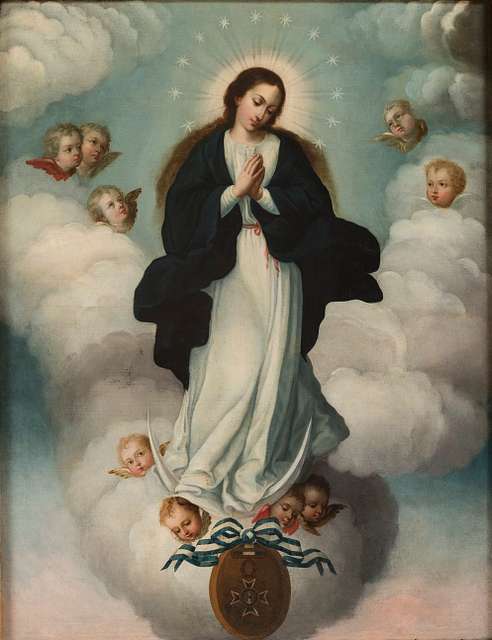
(Above: “Immaculate Conception,” 18th Cent., unknown artist)
Biblical verse
“A great sign appeared in the sky, a woman clothed with the sun, with the moon under her feet, and on her head a crown of twelve stars. She was with child” (Rev. 12:1-2).
What is a great sign in the sky? The full moon. Also, a woman would be clothed by the sun if she ovulated in synchronicity to the full moon: The full moon wears clothes, since that lunar splendor is superficial sun light. Further, a woman is metaphorically clothed at ovulation. In contrast, she’s naked at her menses. Also, at ovulation, a woman is with child even if there is no conception.
Powerfully, when this particular image of Mary is held as a supreme, feminine icon for all women, women should want to cycle themselves to the moon, since doing so would be the height of social acceptability.
Importantly, women who cycle with the moon feel more secure in their lives: Stability for women more exists when they are in visual harmony with the universe. Actually, even if such women (who cycle with the moon) do not realize it, those women are aligned with Mary, the Queen of Heaven, who is represented by the moon, which is, itself, the symbol of femininity: There are 28 days to an average woman’s cycle in homage to the moon, created before humanity. (Importantly, it is likely that the ancients better knew how to both sync female cycles to the moon phases and sync together the cycles of multiple females who were in a single community. Also, the ancients could have had tricks, such as dietary practices, to make baby-sex selection more likely to succeed.)
In contrast, the sun, according to Biblical symbolism, represents masculinity. That parallel is first expressed in the Old Testament, in the Genesis 37:9-10 account of Joseph’s dream of the sun and moon and stars bowing down to him: The sun was his father, the moon, his mother, and the stars, his siblings.
In the above icon, Mary’s head is crowned (that is, encircled) by twelve stars. That symbolism I also freshly interpret to mean the following: The circle of stars represents both the circular, yearly pattern of an eventual return to first month of a new year as well as the full moon itself, which is a big circle. Also, the twelve stars represent the number of full moons in a year (as there are sometimes 13 full moons in a year, in those years, the 13th full moon can be seen as Mary’s own head).
That interpretation make sense according to the same Genesis verse: The icon’s stars representing lunar months would mean that the stars are all sisters–which they are, since they each represent nearly the same thing: a lunar month with a slight difference, such as an appearance in another season.
More meaning
The crown of stars over Mary’s head in this fertility symbol can have other meaning. For one, it can hint, since a crown is what controls, that a female is controlled by her cycle. That is, the individual days of her cycle, and the particular changes that each day brings, influence a woman’s mind and mood.
Too, the crown can have moral symbolism related to sexuality. For instance, the crown can inform women that they are meant to have more control over the times of their sexual activity: A husband might desire to have sexual intercourse with his wife at any time. However, those who imitate Mary do not have sex at a time that feels inappropriate to those women. A queen, with a crown, is not forced to do something that she does not want to do.
Therefore, this icon empowers women to channel their sexuality properly for reproductive purposes and for health reasons—which include but are not limited to the scientifically proven physical and psychological benefits that biological mothers receive.
This truly wondrous icon also sexually tames men who venerate Mary so that the husbands more transform from animals into gentlemen: Because every good wife is meant to imitate Mary, Christian men are meant to allow their wives the opportunity to imitate Mary!
The snake
Some icons show Mary stomping upon a snake while standing on the crescent moon. I myself newly interpret that such a snake was also once recognized as a symbol for the male, genital organ: Like a snake that first lies still, waits, and then springs up, a coiled phallus can jump out at once. So, Mary stomping upon the snake can mean that Mary (speaking of her in her role as the symbol of all women) is not meant to have intercourse at a time that’s unsuited to her: She stomps upon the snake (stops sexual activity) when she stands on the moon—at her cycle’s start or its exit (since the crescent moon can be seen as waxing or waning).
Also, and to speak of practical health matters, a female who avoids intercourse during menstruation should better prevent urinary infections, endometriosis, etc.: The body is the temple.
Handmaiden of God, the Creator
This novel interpretation has further deep, practical meaning: By the nature that God created, a woman should physically feel best to engage in intercourse when she is most fertile. At that time, before and during ovulation, a female’s body releases hormones that incline her mood toward lovemaking. And, who is Mary? A handmaiden of God the Creator, that is, a female who accepts the physical form in which she was created. Therefore, if God has decreed that sexual activity naturally feels best for a woman at a certain time of the month, that must be the time to have sex for those women who trust God.
Theological note: The previous is not at all discussing or commenting either upon Mary herself or her virginal status. Rather, what is being brought up is this icon’s applicability to all women as a fertility symbol: Mary is the perfection of Eve; and, Eve, mother of all, is what applies to all women.
Cherubim are . . . sperm?!
To return to the earlier icon of Mary surrounded by stars and clouds, did you ever wonder why cherubim are portrayed as males? Perhaps, because they can be, in one prime way, originally meant to symbolize sperm! That’s my own opinion (which seems to have been, per expert report, a theory overlooked by art historians).
Looking at that same icon of Mary, what else might those cherubim symbolize? There are nine, so that they could, in this particular icon, also symbolize the months of birth. However, nine months of birth are solar months. There are ten lunar months of birth (to correspond to the number of both hands’ fingers). So, as the icon regards the moon, is the medallion at its bottom representative of the last lunar month?
If that is true, I believe that the medallion would actually represent the first lunar month: in which there was the conception. I say that because a first-time mother’s quickening usually happens halfway through a pregnancy; and, in the above icon, there are five cherubim at top. Thus, if there exists a 5-5 division, that can match the pregnancy phenomenon of the baby first starting to move, which was, once upon a time, considered a really big deal.
——————
www.HeavenlyRevelation.com homepage
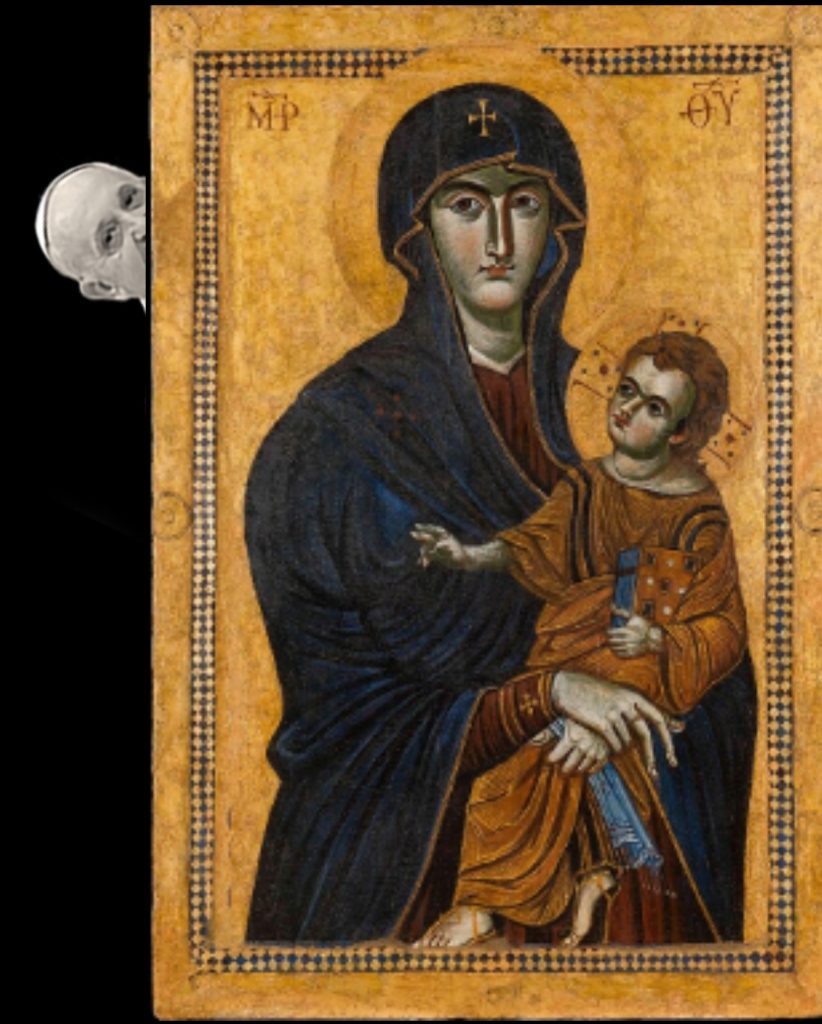
Both a new, heavenly communication from what is considered by Catholics to be the world’s most important icon of Our Lady (the Salus Populi Romani) and an otherworldly message from Pope Francis’ soul in support of that new communication from what was Pope Francis’ favorite image of the Madonna! (Note: Pope Francis is buried mere meters away from this holy icon that communicated on Holy Saturday 2025, two days before the pontiff died.)
Contains a link to an interview about Our Lady’s communication by a well-known paranormal investigator. Due to a synchronicity involving Kylie Jenner that was only in God’s hands, there is, for believers, a measure of obvious-to-see evidence that reveals that the Holy Spirit is supporting Our Lady’s new, urgently needed message that fights against the plastic surgery trend. Deep down, that dangerous and vain trend eats away at the self-esteem of females who attempt to be something that they really are not: If Kylie Jenner needs plastic surgery for the sake of her self esteem, she, in her inner psychology, cannot truly be pleased with her own self. That is a shame considering how beautiful was her original self. Moreover, anyone who wants to see her augmented by dangerous plastic surgery cannot really love her, since the surgery endangers her for the sake of mere appearances. Vanity is a deadly sin.

Click to read sample pages and to acquire this angelic, highly intellectual book that, in its title and in one sentence, newly explains why God allows evil! Available on Amazon (location of the above link) and elsewhere (at this other link).
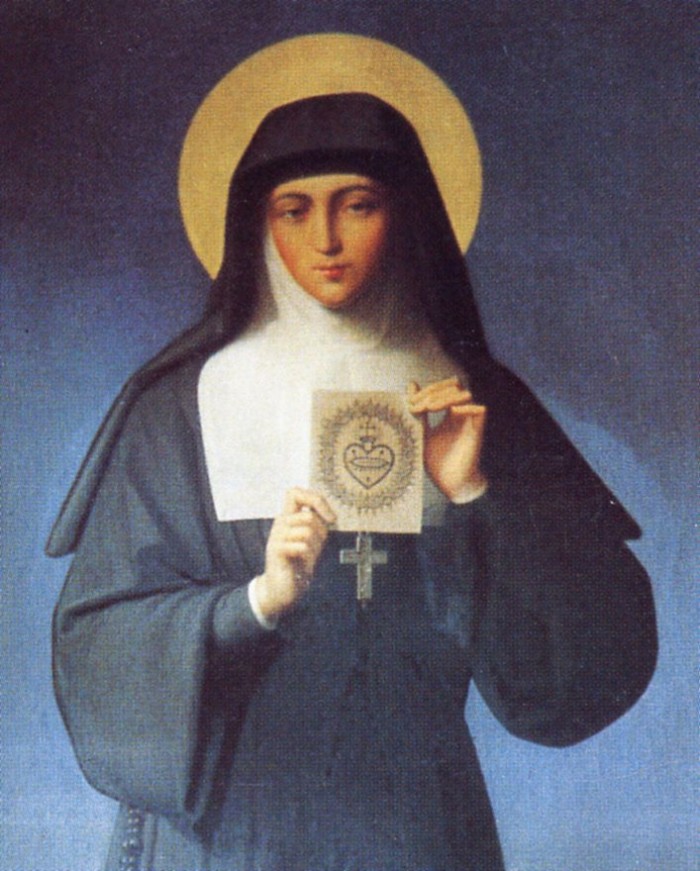
2021, 12-minute video about the same author’s 2019 revelation about the Sacred Heart, filmed in a Palermo church (the video is on Vimeo; and, you may need to sign up for a free account to see it)
